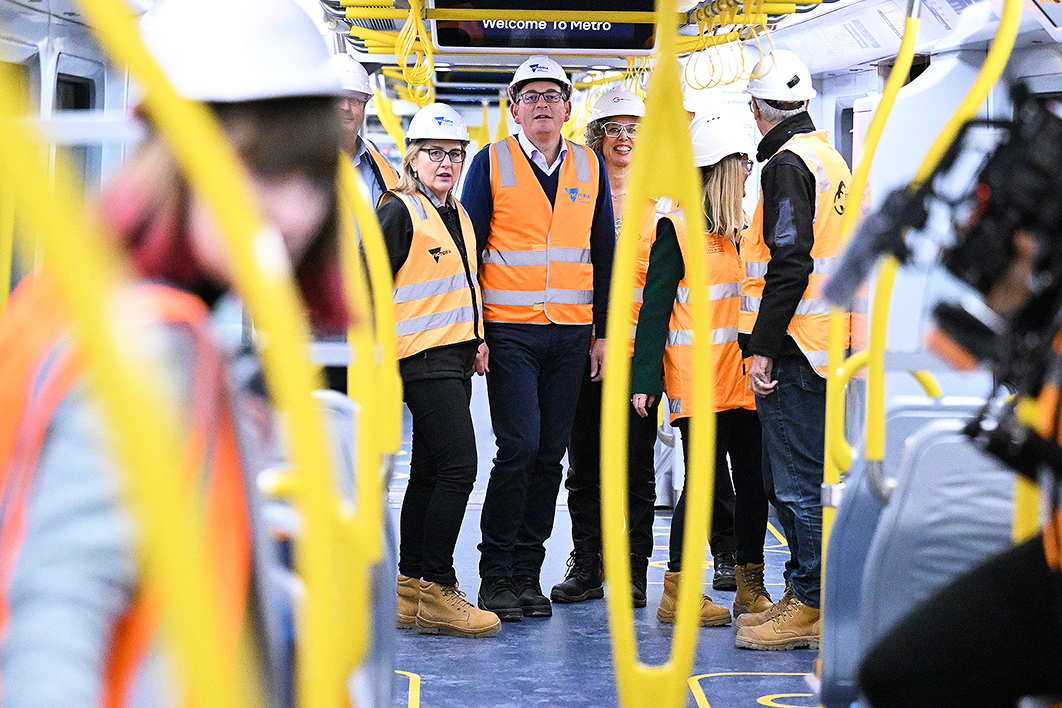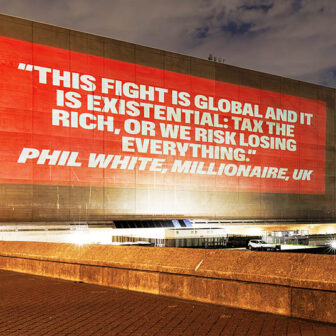Hours before announcing his retirement, Daniel Andrews released a video showing the “Big Build” premier inspecting testing work on the Melbourne Metro, a gargantuan subway line under the city centre. This was Andrews in his natural habitat, hi-vis vest in place, hard hat fastened, pointing and inspecting proprietarily — Victoria’s pharaoh bringing mighty monuments into being.
To be sure, it is a familiar enough sight in Australian politics more broadly — ours is a political class obsessed with infrastructure boondoggles — but for the Andrews government major projects were more than a recurring theme; they were the state religion. The premier performed the rites of sod turning and site inspecting as regularly as Mass and recited figures on level crossings removed or hospitals built like counting rosary beads.
And he backed up these prayers and incantations with billions of dollars. As of the last budget, Victoria had approximately $200 billion in projects under way, and was planning to spend an average of almost $20 billion a year over the coming four years on its infrastructure program.
So big was the Big Build — fiscally, politically, physically — that it competes with the state’s traumatic lockdown experience as the dominant element of Daniel Andrews’s legacy. The psychological scars of that time will stay with many of us for a lifetime, but Andrews’s projects are the very fabric of our daily lives. Millions of Victorians use the infrastructure built over the past nine years several times a day. They envelope Melbourne and wind out into the regions, many of them dominating our skylines or otherwise rearranging our neighbourhoods. It is a legacy inscribed in the physical, in concrete and steel; Danist monuments in nearly every quarter of the state.
But what does this tangle of level crossings and tram upgrades, flyovers and tunnels, hospital wards and transmission cables add up to? What, beyond a personal message from Dan to “look on my works, ye mighty, and despair,” does all this stuff actually mean? What is the Andrews infrastructure legacy?
The first thing to say is that the Big Build’s message isn’t coherent. The Andrews government has never adopted a formal, public, long-term infrastructure strategy. It has published documents that claim to put the state’s many and various projects together, but these are retrofilled scrapbooks based around projects chosen with little consideration of how they all work together. As I have argued previously, the Big Build is ad hocery writ large. That makes the program especially vulnerable to the seductions of the boondoggle — projects that look impressive on paper but don’t work out to be all that helpful in practice.
These problematic projects are easier to catch out in the framework of a long-term plan — new schemes only get in if they actually fit into the bigger picture, meet the overarching goals, work well with the other elements. Andrews’s Big Build fails to do this. At best, it speaks of expedience and pragmatism — build now; don’t let the perfect be the enemy of the good. At worst, it is cynically opportunist — build something, anything, and we will get the political dividend. Who cares if it works in the long run? They might as well be pyramids.
And, in many cases, unfinished pyramids at that. The Melbourne Metro, the megaproject Andrews spruiked on his way out the door, is one of vanishingly few projects running ahead of schedule — and even that project has run billions over budget. Others have been bigger fiascos: the West Gate Tunnel, meant to be a simple project to better connect the Melbourne’s port with road freight, has become a quagmire — ensnared in complicated disputes over contaminated soil, three full years behind schedule and in the neighbourhood of $4.5 billion over budget, or almost double the initial price tag.
The Melbourne Airport Rail, meanwhile, due to connect Tullamarine Airport to the metro rail system in 2029, has been put on pause, alongside the Geelong Fast Rail, pending the federal government’s infrastructure review findings. The Suburban Rail Loop’s total cost has been estimated by the Parliamentary Budget Office at double the original forecast — more than $100 billion for the full project, which isn’t due to be fully complete until the 2080s. These half-built, might-never-be-complete projects stand as monuments to the government’s naivety, its impatience, its imprudence.
Finally, the Big Build tells us interesting things about the role of the state under Andrews. Labor brought with it a renewed commitment to an active and interventionist state — a profound step away from the neoliberal model that had dominated state politics since the coming of Liberal premier Jeff Kennett in 1992. This more active posture has held across a broad range of policy domains, including housing, energy, domestic violence, industrial relations, TAFE, early childhood education, and health product subsidies. The Big Build is the big outlier.
True, the government’s infrastructure program constitutes public investment on a scale unseen for a generation. But the Big Build has also been big business. If Daniel Andrews’s rail bridges and road tunnels, hospital wings and prison expansions had credits chiselled into them, top billing would not belong to the State of Victoria but to private contracting companies, private consultancies, private financiers and toll road operators.
They have been the ones actually doing the building, often at considerable profit. Billions upon billions of public dollars have helped engineering firms, design consultancies, contract lawyers and construction companies not only keep afloat but expand massively. At times, private companies have also been the ones to own the assets at the end — or else new public infrastructure has been financed by the sale of old public assets, as with the Port of Melbourne sale that funded many level crossing removals.
More than this, the private sector is also deeply involved in planning, assessing and even suggesting major projects. These are all roles that were once the domain of the public service. Yes, they have been increasingly outsourced since the Kennett era — it is not a wholly new phenomenon. But under Andrews the trend towards contracting policymaking out has accelerated rather than abated. The private sector now intrudes further into the process than ever before.
Some of the Big Build’s biggest projects have been devised from their earliest stages by the likes of PwC and Transurban. It is companies like this that are setting the priorities, developing ideas, planning routes, proposing programs — policymaking on a vast scale, with an eye-watering budget and long-term consequences for millions of people, devised by private, profit-driven, non-transparent and unaccountable businesses.
The Big Build, then, illustrates the profound alliance Daniel Andrews has forged with big business. While he may have brought back a more interventionist state in many realms of Victorian life, he has also given over swathes of the state’s treasure and territory to the private sector. RMIT politics scholar David Haywood calls it the rise of the Rentier State.
Did it all come to an end this week? Does the exit of Dan, alongside the recent departure of his longstanding infrastructure tsar Corey Hannett, and the end of the cheap finance that fuelled the infrastructure boom, spell the end of the Big Build? We should doubt it. In her first press conference as Labor leader yesterday, Jacinta Allan pointed to her experience as the minister for infrastructure as one of the things that prepared her for the premiership. The projects have been as much hers as Dan’s. When Andrews has been on site, in hi-vis, Allan has been at his side, hardhat fastened. The Big Build will plough on.
But can Allan use the chance of a leadership reset, and a faltering budget situation, to rein in the Big Build’s excesses — to transform it from boondoggle city to a coherent plan that prioritises the needs of the public over the profits of the private sector? Or will she simply continue digging the hole deeper? •




